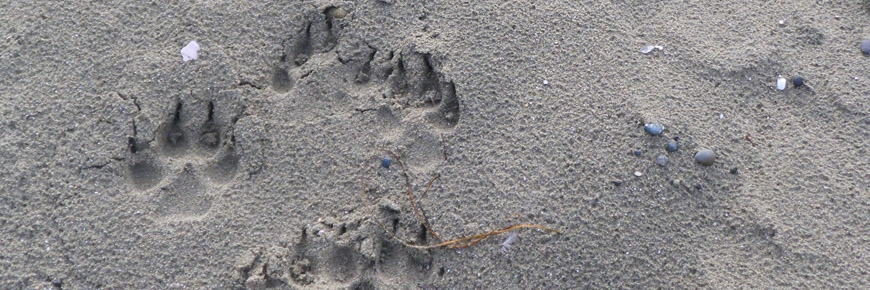
Ecology
Pacific Rim National Park Reserve
Wolf, Bear, and Cougar Life
Wolves, bears, and cougars are some of the more exciting wildlife of this area. It is important to remember that they live in balance with the other wildlife and the habitats around them. The Nuu-chah-nulth Nations of Vancouver Island live by an important concept, hishuk ish ts’awalk – ‘everything is one’. The interconnectedness of species in this area means that a change to one can disrupt the delicate balance with many others.
By carefully respecting the relationships and environmental processes that connect us and the wildlife of Pacific Rim National Park Reserve, we can find a way to live in harmony without impacting the complex balance of this special place. One of the best ways to meet that challenge is to learn about the national park reserve’s inhabitants before you visit.
Appearance and social life
Wolf
Wolves look like German shepherd dogs, but with a narrower chest, longer legs and larger feet. They are also heavier; a large wolf weighs 45 kg. They are efficient long-distance sprinters. Wolves can sprint up to 60-70 km/h. Coastal wolves on Vancouver Island often have a reddish, tawny coat. They tend to be smaller than mainland wolves. You may see a single wolf, a pair, or larger packs.
Cougar
Cougars are the only large cats on Vancouver Island. Longer and heavier than wolves, large males weigh up to 70 kg. From nose to tail tip, they can be 190 cm (longer than an average bed). Their coats are a sandy or tawny colour, and the tail often has a black tip. They are usually solitary and require a large territory. The exception to this is females with their young.
Black Bear
Black bears are the only species of bear living on Vancouver Island. Smaller than grizzly bears, large male black bears weigh up to 275 kg, and females can weigh up to 180 kg; however, most weigh half this amount. While black bears can be a variety of colours elsewhere, here on Vancouver Island they are almost always black. Black bears are typically solitary with large territories and they prefer to give each other plenty of space. The exception to this is sows with their cubs.
Travel behaviours
Wolves and cougars most often travel along trails, roads, beaches, and in sand dunes. These areas provide effective travel corridors where predators can see prey or detect their tracks and scent.
Bears also use these travel corridors, but their presence often depends on seasonal food availability. Bears are seen more frequently in areas where there is fresh grass, berry patches, or easy beach access.
Identifying predator tracks
When bears, wolves, and cougars are wild and wary, they tend to stay out of sight. However, you may find signs that they are in an area, with tracks and scat (droppings) being the most common clues indicating their presence.
Wolf
Claws usually show. The tracks are oval shaped, around 12 cm long by 9 cm wide for an adult, including the claws. The four toe pads are also oval shaped and the overall track is symmetrical. TIP: Domestic dog tracks are usually smaller, they tend to fall in a more haphazard pattern (wolves usually travel in a straight line), and their inner toes spread farther apart than wolf tracks.
Cougar
Their retractable claws usually don’t show. The tracks are generally circular, around 9 cm long by 9.5 cm wide for an adult. The four toe pads are teardrop-shaped and the overall track is non-symmetrical. Due to the shy and elusive nature of cougars, their tracks are spotted less frequently than those of bear and wolves.
Black Bear
Claws usually show. The tracks are large and somewhat resemble human prints, although they are wider. Five toes may be visible, but the small inner toe print is not always visible. The heel pad often shows, especially on the back feet. The tracks are generally oval or triangular in shape, around 14 cm long 11 cm wide by for an adult.
What do these predators eat?
Wolves and cougars are carnivores.
Their diets consist mainly of deer, small mammals (raccoons, river otters, and marten), marine animals (seals and salmon), and birds. Cougars prefer to lick the hair off their food before eating, whereas wolves usually eat all parts of the animal, including their bones and fur. Wolves and cougars see domestic dogs and cats as prey.
Bears are omnivores.
Meat makes up 10-15% of their diet. They have a varied diet that includes grasses and sedges, berries, insects, fish, occasional small mammals, and small marine creatures such as crabs and beach hoppers.
How do these predators hunt?
Cougar
Cougars either stalk or ambush their prey. They attempt to get as close as possible to their prey before attacking. They are fast sprinters and are able to leap long distances. They prefer to leap onto their prey from above or behind, and bite the neck or throat. Cougars are most active at dawn and dusk.
Wolf
Wolves can smell prey up to 2 km away. Once they detect potential prey, the pack works together to chase and exhaust the prey before they close in for the attack.
Black Bear
Although black bears occasionally hunt new born deer and elk, more often they are scavengers and eat what is already dead. Most of their food items are small, so they use minimal effort getting food and eat a large amount of it. Spawning salmon in the fall provide a perfect opportunity for bears to gain weight before the winter, and at this time they can consume up to 20,000 calories daily.
- Date modified :